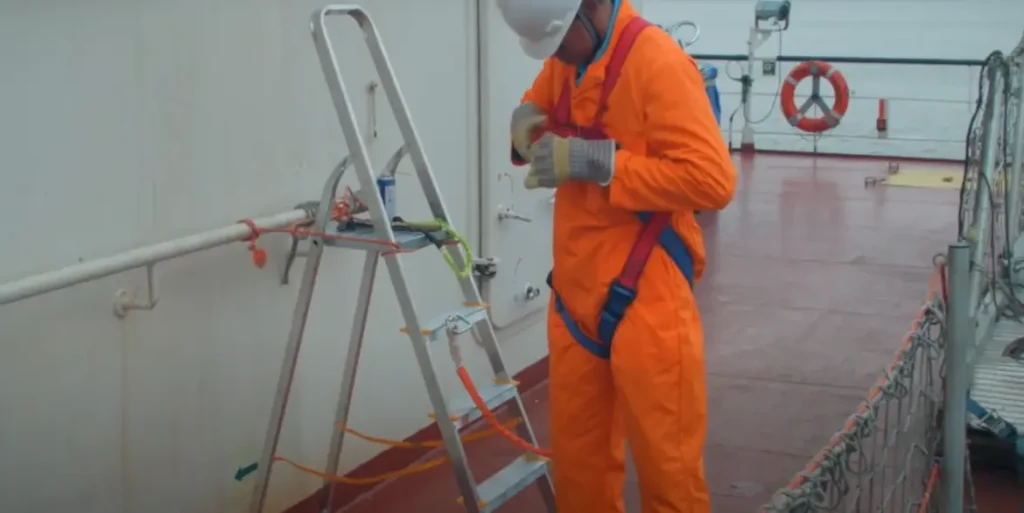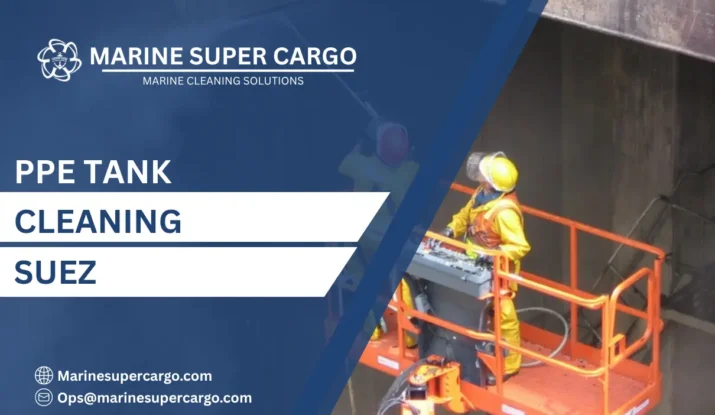Tank cleaning operations in Suez waters present significant hazards requiring comprehensive personal protective equipment protocols. PPE tank cleaning Suez standards protect personnel from chemical exposure, physical injuries, and atmospheric hazards during cargo space maintenance activities. Proper protective equipment selection and usage prove critical for crew safety throughout demanding cleaning operations in Egyptian ports and anchorages.
At Marine Super Cargo, we maintain rigorous PPE tank cleaning Suez protocols that exceed international safety standards and satisfy local regulatory requirements. Our experienced teams understand that effective PPE tank cleaning Suez operations depend on proper equipment selection, crew training, and strict enforcement of safety procedures. The challenging conditions encountered during tank cleaning demand multiple layers of protection addressing diverse hazards throughout cargo spaces.
Regulatory Framework for PPE Requirements
IMO and SOLAS Safety Standards
The International Maritime Organization establishes fundamental safety requirements for maritime operations including tank cleaning activities. SOLAS Chapter II-1 addresses machinery and safety equipment requirements, while the International Safety Management Code mandates systematic approaches to occupational safety. PPE tank cleaning Suez operations must satisfy these international frameworks as minimum safety standards.
The STCW Convention requires appropriate training for personnel engaged in tank cleaning operations, including proper PPE selection and usage. Vessels operating in Suez waters must demonstrate crew competency in safety equipment utilization during port state control inspections.
Egyptian Port Authority Requirements
Suez Port Authority enforces specific PPE tank cleaning Suez standards reflecting local conditions and operational practices. Authority inspectors verify equipment availability, condition, and crew familiarity during vessel examinations. Non-compliant vessels face operational restrictions potentially delaying canal transit or port activities. Marine Super Cargo ensures complete compliance with all Egyptian maritime safety regulations.

Essential PPE Components
Respiratory Protection Systems
Atmospheric hazards during PPE tank cleaning Suez operations require appropriate respiratory protection based on specific conditions encountered. Self-contained breathing apparatus (SCBA) provides the highest protection level for immediately dangerous atmospheres or unknown conditions. Air-supplied respirators offer extended operational capability when connected to external air sources positioned outside cargo spaces.
Personnel working in the bow, stern, or deep tank sections must carry emergency escape breathing devices providing sufficient air for evacuation during equipment failures or unexpected atmospheric deterioration.
Chemical-Resistant Protective Clothing
Full body protection prevents skin contact with hazardous substances during PPE tank cleaning Suez operations. Chemical-resistant suits manufactured from appropriate materials shield personnel from acids, caustics, petroleum products, and specialized cargoes. Suit selection considers cargo properties with materials like Tyvek, PVC, or specialized laminates providing varying protection levels.
One-piece coveralls with sealed seams prevent liquid penetration during washing operations when personnel encounter spray from high-pressure equipment. Marine Super Cargo provides professional-grade protective equipment specifically selected for tank cleaning applications in Suez operations.
Hand and Foot Protection
Chemical-resistant gloves protect hands during PPE tank cleaning Suez activities involving direct contact with residues, cleaning agents, or contaminated equipment. Glove materials must resist degradation from encountered chemicals while maintaining sufficient dexterity for tool operation and equipment handling. Multiple glove types may be necessary addressing different hazards throughout cleaning operations.
Head and Face Protection
Hard hats protect against head injuries from overhead hazards including suspended equipment, low overhead clearances, and falling objects during PPE tank cleaning Suez operations. Chin straps ensure hard hats remain secured when working in confined spaces or during physical exertion.
Face shields provide splash protection during high-pressure washing operations when chemical-laden spray poses eye and face hazards. Full-face respirators integrate respiratory and eye protection for operations in contaminated atmospheres. Safety glasses with side shields offer minimum eye protection during lower-hazard activities.
Hearing Protection
Noise levels during PPE tank cleaning Suez operations frequently exceed safe exposure limits due to ventilation blowers, high-pressure pumps, and washing equipment. Hearing protection ranging from disposable earplugs to electronic muffs reduces noise exposure preventing long-term hearing damage. Communication systems integrated into hearing protection maintain crew coordination during noisy operations.
PPE Selection Based on Cargo Types
Petroleum Cargo Residues
Tank cleaning following petroleum cargo transport requires PPE tank cleaning Suez equipment resistant to hydrocarbon exposure. Chemical suits compatible with oils, respiratory protection against benzene and other aromatics, and flame-resistant materials address petroleum-specific hazards. Static-dissipative footwear prevents static electricity accumulation in potentially explosive atmospheres.
Chemical Cargo Hazards
Acid and caustic cargo residues demand PPE tank cleaning Suez equipment providing enhanced chemical resistance. Specialized suit materials resist corrosive substance penetration while respirators with appropriate cartridges filter chemical vapors. Emergency eyewash and safety showers must be immediately accessible during chemical tank cleaning operations.
Food Grade Operations
PPE tank cleaning Suez requirements for food grade vessels emphasize contamination prevention alongside personnel safety. Clean protective equipment prevents cargo contamination while protecting workers from cleaning agents and physical hazards. Single-use disposable PPE components minimize cross-contamination risks between different food products.
Inspection and Maintenance Protocols
Pre-Use Equipment Checks
Every PPE component requires thorough inspection before PPE tank cleaning Suez operations commence. Visual examination identifies damage, degradation, or contamination that could compromise protection. Respirators undergo function testing verifying proper seal, valve operation, and air flow. Damaged or suspect equipment must be removed from service immediately.
Cleaning and Storage Procedures
Contaminated PPE requires proper cleaning after use preventing chemical exposure during removal and storage. Dedicated washing facilities separate from accommodation areas prevent contamination spread throughout the vessel. Proper storage in designated lockers protects equipment from environmental degradation extending useful life.
Marine Super Cargo maintains comprehensive PPE management systems ensuring equipment readiness for all tank cleaning operations in Suez waters.
Training and Competency Requirements
Effective PPE tank cleaning Suez operations require comprehensive crew training in equipment selection, proper usage, and limitations. Training programs address donning and doffing procedures, fit testing for respiratory protection, and emergency response protocols. Regular drills maintain competency and identify equipment or procedural deficiencies requiring correction.
Documentation of training, fit testing, and equipment inspections satisfies regulatory requirements during MARPOL and port state control inspections.
Frequently Asked Questions
Q1: What type of respirator is required for tank cleaning in Suez?
Respirator type depends on atmospheric conditions—SCBA for IDLH atmospheres, supplied-air for extended operations, or filtering respirators for adequately ventilated spaces.
Q2: How often must PPE equipment be inspected?
Before each use, plus regular scheduled inspections and annual certifications for respiratory protection equipment.
Q3: Are disposable coveralls acceptable for tank cleaning operations?
Yes, when appropriate for encountered hazards and chemical exposures, disposable suits provide adequate protection for many operations.
Q4: What PPE is mandatory for enclosed space entry in Suez?
Minimum requirements include SCBA or supplied-air respirator, chemical-resistant suit, gloves, boots, hard hat, and emergency escape device.
Q5: Who is responsible for PPE provision aboard vessels?
Vessel owners/operators must provide appropriate PPE meeting international and local requirements for all personnel engaged in tank cleaning
Trust Marine Super Cargo for professional PPE tank cleaning Suez services with comprehensive safety protocols protecting personnel throughout all operations.


